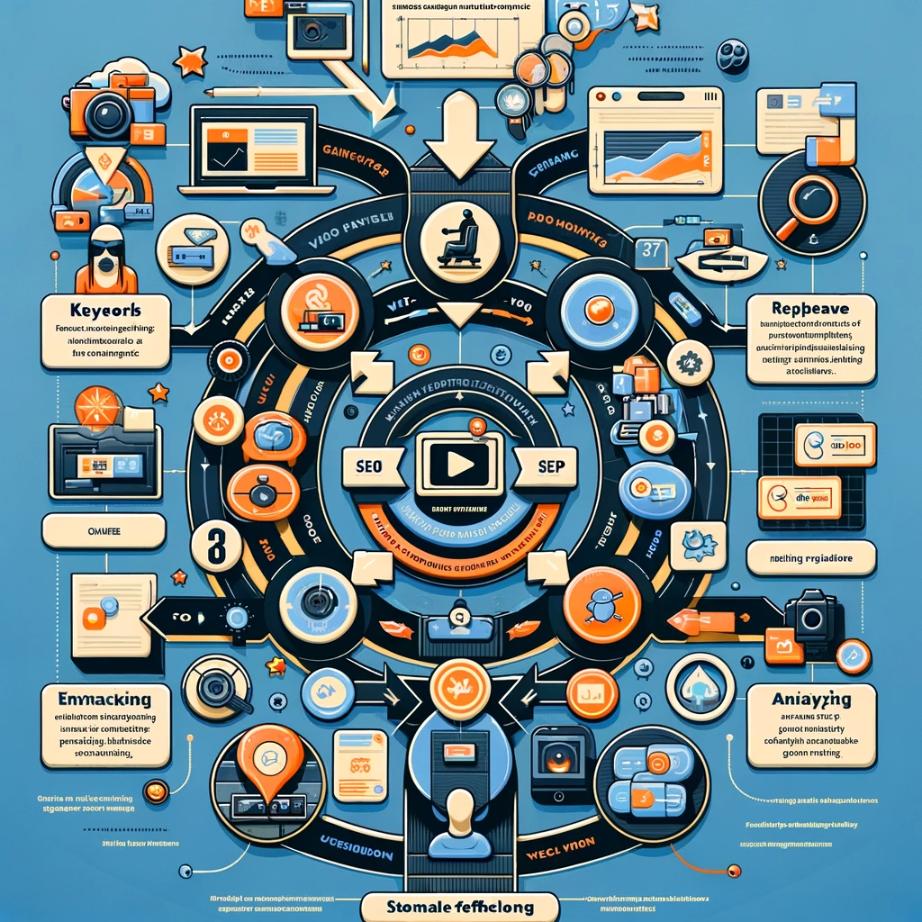YouTube Video Analytics - An Intro For Enhanced Performance
Youtube Video Analytics – In the ever-evolving landscape of YouTube content creation, understanding the intricacies of youtube video analytics is no longer a luxury—it’s a necessity. Whether you’re just starting your journey as a content creator or you’re a seasoned veteran looking to elevate your channel, mastering YouTube video analytics can unlock the door to unprecedented growth and engagement. This intro guide is designed to take you by the hand and delve deep into the world of YouTube analytics, shedding light on the key metrics that matter, how to interpret them, and most importantly, how to use this information to refine your content strategy for maximum impact.
From basic metrics like views and watch time to more nuanced data such as audience retention and click-through rates, we’ll explore the significance of each and provide actionable strategies to leverage your findings. But we won’t stop there. Recognizing that YouTube’s native analytics tools might not cover all bases, we’ll also introduce you to a suite of external tools and resources that complement YouTube’s offerings. These tools can provide deeper insights, helping you to not just understand your audience, but to truly connect with them on a level that fosters loyalty and growth.
Whether your goal is to increase your subscriber count, boost engagement, or simply create more compelling content, this guide promises to equip you with the knowledge and tools necessary to make data-driven decisions. Through a blend of expert advice, best practices, and case studies, we aim to transform the way you approach content creation on YouTube. So, let’s embark on this journey together and unlock the full potential of your YouTube channel through the power of youtube video analytics.
Introduction to YouTube Analytics

YouTube, the world’s largest video sharing platform, offers an unparalleled opportunity for creators to share their content, engage with audiences, and even monetize their work. However, with millions of videos competing for attention, the challenge lies not just in creating content, but in understanding how it performs and resonates with viewers. This is where YouTube Analytics comes into play, serving as a crucial tool in the arsenal of every content creator aiming to navigate the vast sea of digital content successfully.
The Importance of YouTube Analytics in Content Strategy
At its core, YouTube Analytics provides a window into the performance of your videos and your channel as a whole. By offering detailed data on how viewers interact with your content, analytics goes beyond mere numbers; it offers insights into viewer behavior, preferences, and engagement patterns. This data is invaluable for content creators looking to tailor their content strategy to match audience needs, optimize their video performance, and ultimately, achieve their goals, be it increasing viewership, enhancing engagement, or boosting revenue.
Understanding and leveraging YouTube Analytics allows creators to make informed decisions rather than relying on guesswork. It enables a strategic approach to content creation, where every video published is an opportunity to learn more about what works and what doesn’t. This iterative process of analyzing, learning, and adapting is key to sustained growth on the platform.
Understanding the Basics
To harness the power of YouTube Analytics effectively, it’s crucial to start with the basics. Here’s an overview of the fundamental metrics every content creator should be familiar with:
- Views: The cornerstone of YouTube analytics, the view count offers a straightforward measure of a video’s popularity. However, views alone don’t tell the whole story. It’s essential to delve deeper and understand the context behind the numbers, such as how and where these views are being generated.
- Watch Time: Perhaps even more important than views, watch time measures the total amount of time viewers have spent watching your videos. This metric is a key indicator of content quality and engagement, as it reflects actual viewer interest and retention. YouTube’s algorithm favors videos and channels with higher watch times, making this metric a critical focus for creators.
- Subscriber Growth: Tracking subscriber growth helps creators gauge their channel’s overall progress and appeal to new viewers. A rising subscriber count indicates a growing community and suggests that your content strategy is on the right track. Analyzing spikes or dips in subscriber growth can also offer insights into which content resonates most with your audience.
- Engagement (Likes, Comments, Shares): Engagement metrics provide a snapshot of how viewers are interacting with your videos. Likes and dislikes offer immediate feedback on viewer sentiment, while comments can provide qualitative insights into what viewers think and feel about your content. Shares, on the other hand, signal that viewers found your content valuable enough to spread the word. High engagement rates not only foster a sense of community around your channel but can also boost your video’s visibility in YouTube’s algorithm.
By understanding and monitoring these basic metrics, content creators can begin to paint a picture of their channel’s performance and audience preferences. This foundational knowledge is the first step toward developing a content strategy that is both data-driven and audience-focused, setting the stage for sustained growth and success on YouTube.
Deep Dive into Advanced Metrics

Navigating through the world of YouTube analytics reveals a treasure trove of data that, when analyzed correctly, can significantly enhance the performance and reach of your content. Beyond the basic metrics that most creators are familiar with, YouTube offers a suite of advanced metrics that provide deeper insights into viewer behavior and content performance. Understanding these metrics is crucial for any content creator looking to fine-tune their strategy and engage their audience more effectively. In this section, we’ll take a closer look at three advanced metrics: Audience Retention, Click-Through Rate (CTR), and Impression data, alongside Traffic Sources and the role of Demographics and Viewer Interests.
- Audience Retention: Audience Retention is a powerful indicator of how well your content maintains viewers’ interest throughout the video. This metric is presented as a percentage showing the average proportion of a video that viewers watched. A high audience retention rate suggests that your content is engaging and relevant, keeping viewers hooked till the end. Conversely, a drop-off in certain parts might indicate where the content failed to keep the audience’s attention. By analyzing these patterns, you can identify which segments of your videos resonate most with viewers, allowing you to replicate successful elements in future content.
- Click-Through Rate (CTR): Click-Through Rate (CTR) measures how often viewers click on your video after seeing the thumbnail and title. A high CTR means that your video’s title and thumbnail are compelling enough to stand out and encourage viewers to click through and watch. Improving your CTR is essential for increasing your video’s visibility and reach, as YouTube tends to favor content with higher engagement in its recommendation algorithms. Crafting captivating thumbnails and titles that accurately represent the video content can significantly boost your CTR.
- Impression Data: Impressions refer to the number of times your video thumbnails are shown to users on YouTube, including on the homepage, in subscription feeds, and in search results. Tracking impression data alongside CTR gives you insight into how effectively your content is being promoted by YouTube’s algorithm and whether it captures the audience’s interest at first glance. A high number of impressions with a low CTR might indicate a need to revamp your thumbnails and titles for better engagement.
- Analyzing Traffic Sources: Understanding where your viewers are coming from is crucial for tailoring your content distribution strategy. Traffic Sources in YouTube Analytics can tell you whether viewers found your video through search, suggested videos, direct links, or other sources. This information helps you understand what drives traffic to your channel and which platforms or keywords you should focus on to maximize visibility and engagement.
- The Role of Demographics and Viewer Interests: Demographics and Viewer Interests data allow you to tailor your content more effectively to your audience. Knowing the age, gender, geographic location, and interests of your viewers can help you create content that resonates more deeply with them. For example, if your analytics show a strong viewership in a particular country, you might consider creating content that appeals specifically to that audience or even incorporating subtitles in the relevant language.
By diving deep into these advanced metrics, you can uncover invaluable insights that empower you to make informed decisions about your content. This not only helps in improving the quality and relevance of your videos but also in strategizing your content distribution to reach the widest and most engaged audience possible.
Setting Goals and Benchmarking

Setting realistic performance goals and benchmarking are essential steps in leveraging YouTube analytics to guide your channel’s growth and content strategy. These practices help you create a roadmap for success, allowing you to measure progress and make informed decisions about future content and strategies. Here’s how to approach setting goals and benchmarking effectively:
Setting Realistic Performance Goals
- Analyze Current Performance: Before setting new goals, thoroughly review your channel’s current performance metrics. Look at views, subscriber growth, engagement rates, and other relevant analytics to understand where you stand.
- Understand Your Capacity: Be realistic about what you can achieve based on your resources, time, and current audience size. Setting overly ambitious goals without a clear plan can lead to disappointment and burnout.
- SMART Goals: Make sure your goals are Specific, Measurable, Achievable, Relevant, and Time-bound. For example, instead of setting a vague goal like “increase engagement,” a SMART goal would be “increase the average watch time by 10% over the next 3 months.”
- Segment Your Goals: Break down your overarching goals into smaller, actionable objectives. For instance, if your goal is to grow your subscriber base, smaller objectives might include improving your video SEO, increasing your posting frequency, or enhancing viewer interaction in the comments section.
The Importance of Benchmarking
- Benchmarking Against Your Own Performance: Tracking your progress over time is crucial for understanding how your changes impact your channel. Use your past performance as a benchmark to set realistic goals and measure improvement. For example, if you’re aiming to improve audience retention, compare the retention rates of new videos against those of older ones to gauge the effectiveness of changes in your content strategy.
- Competitive Benchmarking: Identifying channels that are similar in size and content to yours can provide valuable insights. Analyze their growth trends, engagement rates, and content strategies. This doesn’t mean copying what others are doing, but rather learning from their successes and mistakes to inform your own strategy.
- Industry Standards and Trends: Stay informed about average performance metrics within your niche. This can help you set more informed goals and understand where your channel stands in comparison to the broader YouTube community.
- Adjusting Goals Based on Benchmarks: Use the insights gained from benchmarking to refine your goals. If you find that certain strategies are particularly effective within your niche, adjust your goals to incorporate these insights. Similarly, if you’re outperforming your benchmarks, it might be time to set more ambitious goals to continue pushing your channel forward.
Setting goals and benchmarking are iterative processes. As you achieve your objectives and gather more data, revisit and adjust your goals to keep them challenging yet achievable. This dynamic approach ensures continuous improvement and helps you stay aligned with the ever-changing landscape of YouTube content creation. By focusing on realistic performance goals and thorough benchmarking, you’ll be better equipped to steer your channel toward long-term success.
Improving Video Performance Using Analytics

Improving video performance on YouTube isn’t just about creating great content; it’s also about understanding and leveraging the wealth of data available through YouTube analytics. By meticulously analyzing your youtube video analytics, you can uncover insights that allow you to optimize your content strategy for better performance. Here’s how you can use analytics data to boost your video’s reach and engagement:
Optimizing Video Titles, Descriptions, and Thumbnails for Higher CTR
- Conduct Keyword Research: Use keyword research tools to find terms that your target audience is searching for. Incorporate these keywords into your video titles and descriptions to improve searchability and relevance.
- A/B Test Thumbnails: Thumbnails are your first impression. Use analytics to identify which types of thumbnails yield the highest CTR. Consider A/B testing different designs, colors, and text overlays to see what resonates best with your audience.
- Compelling Titles and Descriptions: Your title should be clear, compelling, and click-worthy, while also incorporating your target keywords. Your description should provide additional context and include calls-to-action, such as prompting viewers to subscribe or visit your website.
Utilizing Audience Retention Data to Fine-Tune Video Structure and Content Pacing
- Identify Drop-Off Points: Review the Audience Retention curve for each video to pinpoint where viewers tend to lose interest. Use this data to understand what might be causing viewer drop-off, such as lengthy introductions or off-topic tangents.
- Adjust Content Pacing: If you notice a pattern of early drop-offs, consider tightening your video’s opening to get to the main content more quickly. Experiment with pacing, transitions, and editing styles to keep your content dynamic and engaging throughout.
- Replicate Successful Elements: Conversely, take note of segments where retention rates spike or remain high. Analyze what worked well in these segments—whether it was a specific topic, presentation style, or visual element—and aim to replicate these successful components in future videos.
Leveraging Engagement Analytics for Better Visibility
- Encourage Viewer Interaction: Engagement signals like comments, likes, and shares are critical for boosting your video’s visibility on YouTube. Use your video’s outro, pinned comments, or even on-screen graphics to encourage viewers to engage with your content.
- Respond to Comments: Actively engaging with your audience by responding to comments can further increase engagement and foster a sense of community around your channel. High engagement rates signal to YouTube that your content is valuable, potentially increasing its promotion through the platform’s recommendation algorithms.
- Analyze Engagement Trends: Keep an eye on which videos garner the most likes, comments, and shares. Investigate what these videos have in common and how you can incorporate those elements into your content strategy. For instance, if Q&A videos or certain topics generate more engagement, consider producing more content along those lines.
By taking a data-driven approach to content optimization, you can make informed decisions that enhance your video’s appeal and performance. Remember, the goal is not just to attract viewers, but to keep them engaged and coming back for more. Regularly reviewing and acting on your YouTube analytics ensures your content strategy remains dynamic and responsive to your audience’s preferences, ultimately leading to sustained growth and success on the platform.
Supplementary Tools and Resources

While YouTube’s native analytics provide a wealth of data to help creators optimize their content and grow their channels, several external tools offer additional insights and functionalities that can take your analytics game to the next level. By complementing YouTube’s analytics with these third-party tools, creators can gain a more nuanced understanding of their performance and discover new opportunities for optimization and growth. Let’s explore three key tools that are invaluable for any serious YouTube content creator: VidIQ, TubeBuddy, and Social Blade.
VidIQ: Mastering SEO and Competitor Analysis
VidIQ is a powerful tool designed to help YouTube creators maximize their channel’s potential through keyword research, competitor analysis, and SEO optimization. With VidIQ, you can:
- Identify Trending Keywords: Discover what your target audience is searching for and optimize your video titles, descriptions, and tags to improve visibility.
- Analyze Competitors: Gain insights into your competitor’s strategies, including which keywords they’re targeting and how their videos perform. This can help you identify gaps in your content strategy and areas for improvement.
- Track Video Performance: VidIQ offers detailed analytics on video performance, including engagement rates and SEO scores, helping you understand what works and what doesn’t.
TubeBuddy: Enhancing Productivity and Performance
TubeBuddy is another essential tool that offers a suite of features to streamline content creation and enhance video performance. Key features include:
- A/B Testing: One of TubeBuddy’s standout features is its ability to conduct A/B tests for video thumbnails, titles, and descriptions, allowing you to determine which variations drive the highest engagement and CTR.
- Scheduling and Productivity Tools: TubeBuddy offers advanced scheduling options, making it easier to plan and publish your content. Additionally, its productivity tools help streamline common tasks, saving you time and effort.
- SEO Recommendations: Receive tailored suggestions on how to improve your video’s SEO, from optimizing your title and description to selecting the right tags.
Social Blade: Tracking Growth and Benchmarking
Social Blade is a tool that specializes in tracking YouTube channel statistics and analytics over time. It’s particularly useful for:
- Growth Tracking: Monitor your channel’s growth in terms of subscribers and views over time. This can help you identify trends and assess the impact of specific content strategies.
- Comparing Channels: Social Blade makes it easy to compare your channel’s performance against competitors, providing insights into how you stack up in terms of growth, engagement, and overall rankings.
- Benchmarking Success: Use Social Blade’s data to set benchmarks and goals for your channel based on industry standards and the performance of similar channels.
These supplementary tools can provide insights that aren’t available through YouTube’s native analytics alone, from detailed SEO optimization suggestions to competitive benchmarking and beyond. By integrating VidIQ, TubeBuddy, and Social Blade into your analytics toolkit, you can uncover new strategies for growth, optimize your content for better performance, and ultimately, achieve greater success on YouTube.
Actionable Insights and Analytics Best Practices
Harnessing the power of YouTube analytics is not just about collecting data; it’s about translating that data into actionable insights and implementing changes that drive tangible improvements in your channel’s performance. Here are some best practices for regularly reviewing and acting on analytics data, creating a feedback loop for continuous improvement, and learning from the success stories of other YouTubers.
Regular Review and Action on Analytics Data
- Schedule Regular Analytics Reviews: Dedicate time weekly or monthly to dive deep into your YouTube analytics. This consistent review helps you stay on top of trends, viewer behavior, and any sudden changes in your video performance.
- Focus on Key Performance Indicators (KPIs): Identify the most important metrics for your channel’s goals, whether it’s watch time, subscriber growth, or engagement rates. Concentrating on these KPIs can help streamline your analysis and focus your efforts on what truly matters.
- Use Data to Inform Content Strategy: Let analytics guide your content creation. If certain types of videos consistently perform well, consider producing more content in that vein. Conversely, if some videos underperform, it might be time to reassess and pivot your strategy.
Creating a Feedback Loop
- Implement Changes Based on Insights: Use the insights gained from your analytics review to make informed decisions about your content, whether it’s tweaking your video titles for better SEO, adjusting your upload schedule, or experimenting with new content formats.
- Measure the Impact of Changes: After implementing changes, closely monitor the relevant metrics to assess the impact. This could involve comparing the performance of new videos against your established benchmarks or previous content.
- Iterate and Refine: Content creation is an ongoing learning process. Use the data from your experiments to refine your approach, making small, incremental improvements over time. This feedback loop ensures your content strategy evolves in alignment with your audience’s preferences and behaviors.
These best practices underscore the importance of a data-driven approach to YouTube content creation. By regularly reviewing analytics, creating a feedback loop, and learning from the success of others, you can make informed decisions that enhance your content’s performance and accelerate your channel’s growth.
Future Trends in Video Analytics

The landscape of youtube video analytics is evolving rapidly, driven by advancements in technology and the increasing importance of data-driven content strategies. As YouTube and other platforms continue to innovate, and as tools leveraging artificial intelligence (AI) and machine learning (ML) become more sophisticated, creators have much to look forward to. Understanding these future trends can help creators stay ahead of the curve and make the most of their content and channel performance. Here’s a glimpse into what the future might hold for youtube video analytics and how these advancements could impact content creators.
Upcoming Features in Analytics Tools and YouTube
Enhanced Real-Time Analytics: Expect analytics tools to offer more detailed real-time data, giving creators instant feedback on their content’s performance. This could include real-time engagement metrics, viewer demographics, and more nuanced viewer reactions, enabling creators to adjust their strategies promptly.
Predictive Analytics: Advanced tools may soon offer predictive analytics, using past performance data to forecast future trends, such as potential viewer growth, content preferences, and engagement levels. This will allow creators to plan their content more strategically, focusing on topics and formats predicted to perform well.
Integrated Cross-Platform Analytics: As creators distribute content across multiple platforms, the demand for integrated analytics solutions will grow. These tools will aggregate data from various sources, providing a comprehensive view of a creator’s overall online presence and the synergies between different platforms.
The Impact of AI and Machine Learning on Youtube Video Analytics and Content Optimization
Content Recommendation Optimization: AI and ML algorithms are set to become even more sophisticated in analyzing viewer preferences and behavior, leading to more personalized content recommendations. This precision in content matching will help creators reach more relevant audiences, increasing views and engagement.
Automated Video Analysis: AI-powered tools will be able to analyze video content itself, not just metadata, to provide insights into the elements that make a video successful. This could include analysis of video pacing, sentiment, and visual elements, offering actionable suggestions for content improvement.
Enhanced SEO Strategies: AI and ML will also revolutionize SEO strategies for video content. By analyzing vast amounts of data, these technologies can identify emerging search trends and suggest optimization strategies for titles, descriptions, and tags that are most likely to increase visibility and attract viewers.
Viewer Sentiment Analysis: Future analytics tools may offer deeper insights into viewer sentiment, going beyond likes and comments to gauge the emotional response to a video. This could help creators fine-tune their content to better resonate with their audience, improving viewer satisfaction and loyalty.
Content Creation Assistance: AI might soon play a direct role in content creation, suggesting topics, scripts, or even editing videos based on analysis of what’s likely to succeed. While the creative input of the creator will remain irreplaceable, AI could serve as a valuable assistant, streamlining the content creation process and enhancing output quality.
As youtube video analytics continue to evolve, creators should stay informed about these trends and be ready to adapt their strategies. Embracing the opportunities presented by AI and ML can not only improve content performance but also unlock new creative possibilities, helping creators to engage their audience more effectively and grow their channels in the dynamic digital landscape.
Conclusion
In the fast-paced world of YouTube content creation, understanding and leveraging youtube video analytics stands as a cornerstone for success. This comprehensive guide has journeyed through the foundational elements of YouTube analytics, delved into advanced metrics, and explored the cutting-edge tools and future trends that are shaping the landscape of content optimization. Our aim has been to equip you, the content creator, with a robust intro toolkit of knowledge and strategies to harness the power of analytics, transforming raw data into actionable insights.
By embracing the practices outlined in this guide—from optimizing your video titles and thumbnails to enhance click-through rates, to leveraging audience retention data for content pacing, and beyond—you’re not just reacting to the numbers. You’re engaging in a proactive process of continuous improvement, setting your channel apart in a crowded digital arena.
Remember, the journey doesn’t end with understanding your current analytics. The future of video content is dynamic, with AI and machine learning poised to offer even deeper insights and automation in content creation and optimization. Staying informed about these advancements will ensure that your content strategy remains agile and forward-thinking, ready to adapt to the changing tides of viewer preferences and technological innovation.
This guide is more than just a resource; it’s a companion in your ongoing quest for YouTube excellence. By applying the insights and strategies discussed, you’ll be well-equipped to elevate your channel’s performance, foster deeper engagement with your audience, and navigate the exciting future of youtube video analytics with confidence. The path to YouTube success is paved with data-driven decisions, and now, you have the map to guide your way.
